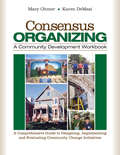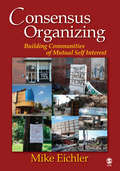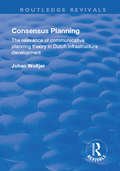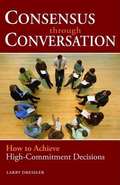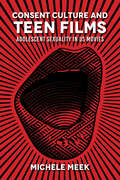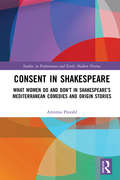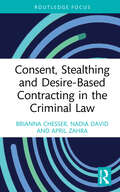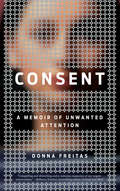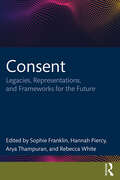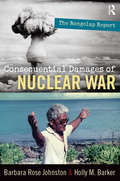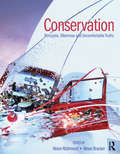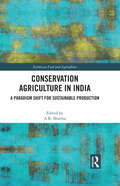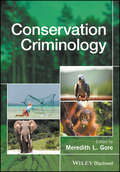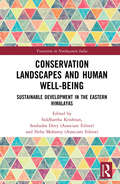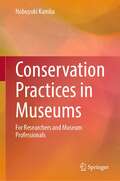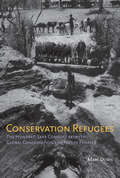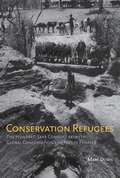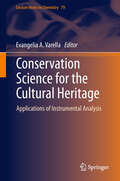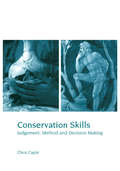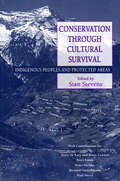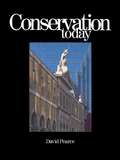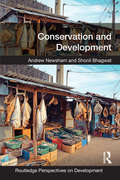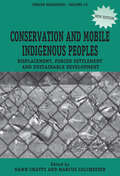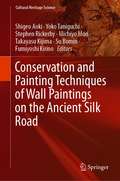- Table View
- List View
Consensus Organizing: A Comprehensive Guide to Designing, Implementing, and Evaluating Community Change Initiatives
by Mary L. Ohmer Karen DeMasi"The world is changing rapidly and the practice of community organizing needs to change with it. Representing both an homage to, and a departure from the "alinsky traditions" of organizing, Consensus Organizing offers techniques that are specifically designed for urban and rural communities struggling to succeed in the global economy and the information age. Ohmer and DeMasi are experienced organizers who offer a relentlessly thorough examination of the process of bringing diverse communities together to make change and to bridge the ethnic and economic divisions that keep many communities from succeeding."—Bill Traynor Executive Director, Lawrence CommunityWorks Inc.A person doesn′t have to be a consensus organizer to think like one. Consensus Organizing: A Community Development Workbook—A Comprehensive Guide to Designing, Implementing, and Evaluating Community Change Initiatives helps students and practitioners begin to think like consensus organizers and incorporate this way of strategic thinking into their lives and their work. Through a wide range of exercises, role-play activities, case scenarios, and discussion questions, this workbook presents the conceptual framework for consensus organizing and provides a practical and experiential approach to understanding and applying consensus organizing to address a range of issues. This workbook is designed to be used by itself or along with Mike Eichler′s text Consensus Organizing: Building Communities of Mutual Self Interest (SAGE, 2007). Key Features and Benefits Provides a step-by-step guide on how to conduct a community analysis of both internal and external neighborhood resources Brings consensus organizing to life through case studies based on the real-life experiences of the authors Offers field exercises that engage the reader in applying and practicing consensus organizing Provides practical tools that community organizers and practitioners can use in their daily work Includes a sample job description, work plan, monitoring report, and field report for hiring and supervising consensus organizers Presents tools for describing and evaluating consensus organizing and community-level interventions Accompanying Website Instructors and students have access to the many activities and cases on the accompanying website.
Consensus Organizing: Building Communities of Mutual Self Interest
by Michael P. EichlerEmpowering a community takes more than organizing and mobilizing its people; it takes a simple, yet radical, notion that consensus can be reached by creating mutual self interest between key individuals in the community and players of interest. In Consensus Organizing: Building Communities of Mutual Self Interest, author Mike Eichler shows how even poor and disempowered communities can achieve lasting results by implementing some key consensus organizing strategies. Through personal, lively, and relevant examples, Eichler takes the reader on a road trip through various communities and shows how collectively they were able to reach lasting results by finding key areas where consensus could be reached. Key features: The author shares his twenty-five years of experience as a community organizer, including the development of a national effort to train young people as consensus organizers in diverse locations such as Las Vegas, New Orleans, and New York City. Demonstrates how consensus organizing can be applied to a variety of settings, including public education, housing, economic development, health and crime. Gives readers the opportunity to learn more about themselves: It helps students to see the other side of any situation and understand how common ground can be achieved. It is written in a student-friendly, conversational manner, which will make students feel as if they have taken a journey with the author, struggled with the various communities, won the victories with the disempowered, and had a few laughs along the way. Intended audience: This book can be used as a core textbook for courses in community organizing and as a supplemental volume in various macro social work courses on community practice. It can also be used in departments of social work, urban planning, public administration, and public health.
Consensus Planning: The Relevance of Communicative Planning Theory in Duth Infrastructure Development
by Johan WoltjerThis title was published in 2000: This text offers a standpoint on communicative, participatory planning called "consensus planning". The discussion takes place in the Netherlands, where consensus-based decision-making is part of the national heritage. The book explores recent Dutch infrastructure development experiences and concludes that communicative planning theory does not offer uniform relevance for the challenges that planning practitioners face. Building on these experiences, it proposes the concept of consensus planning as valuable in a complementary, normalized, and contingent way. Consensus planning, in other words, has diverse practical appearances and sometimes may not exist or be desirable.
Consensus Through Conversation: How to Achieve High-Commitment Decisions
by Larry DresslerIt explains how the "leader as brain, employees as body" model is disappearing, as more and more organizations are realizing that sustained change comes from people who are personally committed to a future that they have helped create.
Consent Culture and Teen Films: Adolescent Sexuality in US Movies
by Michele MeekTeen films of the 1980s were notorious for treating consent as irrelevant, with scenes of boys spying in girls' locker rooms and tricking girls into sex. While contemporary movies now routinely prioritize consent, ensure date rape is no longer a joke, and celebrate girls' desires, sexual consent remains a problematic and often elusive ideal in teen films.In Consent Culture and Teen Films, Michele Meek traces the history of adolescent sexuality in US cinema and examines how several films from the 2000s, including Blockers, To All the Boys I've Loved Before, The Kissing Booth, and Alex Strangelove, take consent into account. Yet, at the same time, Meek reveals that teen films expose how affirmative consent ("yes means yes") fails to protect youth from unwanted and unpleasant sexual encounters. By highlighting ambiguous sexual interactions in teen films—such as girls' failure to obtain consent from boys, queer teens subjected to conversion therapy camps, and youth manipulated into sexual relationships with adults—Meek unravels some of consent's intricacies rather than relying on oversimplification.By exposing affirmative consent in teen films as gendered, heteronormative, and cis-centered, Consent Culture and Teen Films suggests we must continue building a more inclusive consent framework that normalizes youth sexual desire and agency with all its complexities and ambivalences.
Consent in Shakespeare: What Women Do and Don’t Say and Do in Shakespeare’s Mediterranean Comedies and Origin Stories (Studies in Performance and Early Modern Drama)
by Artemis PreeshlBy examining how female characters speak and act during coming of age, engagement, marriage, and intimacy, Consent in Shakespeare will enhance understanding about how and why women spoke, remained silent, or acted as they did in relation to their intimate partners in Early Modern and contemporary private and public situations in and around the Mediterranean. Consent in intimate relationships is front and center in today’s conversations. This book re-examines the verbal and physical interactions of female-identified characters in Early Modern and contemporary cultures in Shakespeare’s Mediterranean comedies and the sources from which he derived his plays. This re-examination of the words that women say or do not say, and actions that women do or do not take, in Shakespeare’s Mediterranean plays and his probable sources sheds light on how Shakespeare’s audiences might have perceived Mediterranean cultural mores and norms. Assessment of source materials for Shakespeare’s comedies set in the Balkans, France, Italy, the Near East, North Africa, and Spain suggests how women of diverse backgrounds communicated in everyday life and peak life experiences in the Early Modern era. Given Shakespeare’s impact worldwide, this initiative to shift the conversation about the power of consent of female protagonists and supporting characters in Shakespeare’s Mediterranean plays will further transform conversations about consent in class, board and conference rooms, and the international stage.
Consent in Shakespeare’s Classical Mediterranean: Women Speak Truth to Power (Routledge Advances in Theatre & Performance Studies)
by Artemis PreeshlConsent in Shakespeare’s Classical Mediterranean fills a gap in knowledge about how female-identified, gender-fluid, and non-binary characters made choices about intimacy, engagement, and marriage in Shakespeare’s classical Mediterranean plays.This classical sequel explores how female-identified, gender-fluid, and non-binary characters accessed agency in Shakespeare’s Mediterranean plays set in classical Troy, Athens, Thebes, Antioch, Ephesus, Mytilene, the North African Pentapolis, Tarsus, Egypt, Rome, Antium, Britain, Sardis, Philippi, Sicily, greater Bohemia, and the Balkan region. Through the lens of sources from Eastern and Western Europe, the Middle East, and the Maghrib, Shakespeare’s heroines and their supporters may have initially appeared to conform to Early Modern contexts, but the diverse backgrounds of female-identified, gender-fluid, and non-binary characters impacted the right to consent to friendship, affection, betrothal, and marriage in the classical Mediterranean. By focusing on perspective views about female-identified, gender-fluid, and non-binary characters in and around Eastern and Western Europe, the Middle East, and the Maghreb, classical realities collide with Early Modern preconceptions and misconceptions to reveal commonalities and differences in the lived experiences of female-identified and non-binary royalty, nobility, servants, enslaved peoples, matchmakers, courtesans, sex workers, madams, herbalists, tailors, and merchants.This study will be of great interest to students and scholars in Theatre, Middle East Studies, Asian Studies, Eastern European and Eurasian Studies, African and Maghrib Studies, and Social Justice Studies.
Consent, Stealthing and Desire-Based Contracting in the Criminal Law (Routledge Frontiers of Criminal Justice)
by Brianna Jade Chesser Nadia David April ZahraConsent, Stealthing and Desire-Based Contracting in the Criminal Law examines the inconsistencies in the definitions of consent in sexual encounters by examining emerging sex crimes alongside changing community values and the changing legal definitions of consent in sexual offending, focusing on common law and civil law countries. This book distinguishes itself through the use of empirically validated research strategies and an in-depth analysis of current legislative regimes. It argues that desire and pleasure are largely ignored by legal consent definitions, despite its importance in sexuality more broadly. Using two case studies of emerging forms of sexual offending, the criminalisation of sadomasochistic sexual practices and the offence of ‘stealthing’, it examines how the law is both a blunt and under-utilised instrument in the policing of people’s sexual relationships. The presence or absence of consent can change a lawful sexual act between two people into a serious crime with potentially devastating consequences to both survivor and offender. Yet there remains no consistent definition of consent applied within and between legal jurisdictions across the world. A comparative analysis reveals parallels between common law countries and civil law countries. The book also provides a brief history of the use of term consent in relation to sexual offending and examines definitional and sociological requirements of conceptual consent across history. Covering jurisdictions in the US, UK, and Australia, providing an innovative resource on issues relating to consent presented in an accessible way, this book will appeal to students and researchers of criminal justice, criminal law, criminology, sociology and gender studies.
Consent: A Memoir of Unwanted Attention
by Donna Freitas"Consent is compelling and disturbing and a welcome expansion of our urgent conversation"--Rebecca Traister Donna Freitas has lived two lives. In one life, she is a well-published author and respected scholar who has traveled around the country speaking about Title IX, consent, religion, and sex on college campuses. In the other, she is a victim, a woman who suffered and suffers still because she was stalked by her graduate professor for more than two years. As a doctoral candidate, Freitas loved asking big questions, challenging established theories and sinking her teeth into sacred texts. She felt at home in the library, and safe in the book-lined offices of scholars whom she admired. But during her first year, one particular scholar became obsessed with Freitas' academic enthusiasm. He filled her student mailbox with letters and articles. He lurked on the sidewalk outside her apartment. He called daily and left nagging voicemails. He befriended her mother, and made himself comfortable in her family's home. He wouldn't go away. While his attraction was not overtly sexual, it was undeniably inappropriate, and most importantly--unwanted. In Consent: A Memoir of Unwanted Attention, Donna Freitas delivers a forensic examination of the years she spent stalked by her professor, and uses her nightmarish experience to examine the ways in which we stigmatize, debate, and attempt to understand consent today.
Consent: Legacies, Representations, and Frameworks for the Future (Interdisciplinary Research In Gender Ser. #25)
by Rebecca White Sophie Franklin Hannah Piercy Arya ThampuranConsent: Legacies, Representations, and Frameworks for the Future examines the conceptualisation of ‘consent’ across various historical periods, cultures, and disciplines to offer an expansive, pluralistic vision for future articulations of consent as it circulates throughout contemporary life in sexual encounters, medical contexts, and media representations. This volume is distinctive in its diverse conceptual scope and commitment to cross-disciplinary dialogue, accommodating perspectives on consent that are contextually sensitive and culturally diverse. The chapters examine a range of topics, from socio-cultural engagements with consent in Latin American music, feminist movements in Pakistan, and BDSM in Poland, to theoretical and pedagogical ones exploring alternative possibilities for framing and understanding consent through intersectional approaches and institutional curricula. Consent: Legacies, Representations, and Frameworks for the Future is of value to researchers, practitioners, undergraduate and postgraduate students, and general readers interested in histories, representations, and future possibilities of consent in its many manifestations. The Introduction and Afterword of this book are freely available as downloadable Open Access PDFs at http://www.taylorfrancis.com under a Creative Commons Attribution (CC-BY) 4.0 license.
Consequential Damages of Nuclear War: The Rongelap Report
by Barbara Rose Johnston Holly M BarkerThe hydrogen test-bomb Bravo, dropped on the Marshall Islands in 1954, had enormous consequences for the Rongelap people. Anthropologists Barbara Rose Johnston and Holly Barker provide incontrovertible evidence of physical and financial damages to individuals and cultural and psycho-social damages to the community through use of declassified government documents, oral histories and ethnographic research, conducted with the Marshallese community within a unique collaborative framework. Their work helped produce a $1 billion award by the Nuclear Claims Tribunal and raises issues of bioethics, government secrecy, human rights, military testing, and academic activism. The report, reproduced here with accompanying materials, should be read by everyone concerned with the effects of nuclear war and is an essential text for courses in history, environmental studies, bioethics, human rights, and related subjects.
Conservation
by Alison Richmond Alison Bracker'Conservation: Principles, Dilemmas, and Uncomfortable Truths' presents multi-perspective critical analyses of the ethics and principles that guide the conservation of works of art and design, archaeological artefacts, buildings, monuments, and heritage sites on behalf of society. Contributors from the fields of philosophy, sociology, history, art and design history, museology, conservation, architecture, and planning and public policy address a wide range of conservation principles, practices, and theories from the US, Canada, Europe, Australia and New Zealand, encouraging the reader to make comparisons across subjects and disciplines. By wrestling with and offering ways of disentangling the ethical dilemmas confronting those who maintain and sustain cultural heritage for today and tomorrow, 'Conservation: Principles, Dilemmas, and Uncomfortable Truths' provides an essential reference text for conservation professionals, museum and heritage professionals, art and cultural historians, lecturers and students, and all others invested in cultural heritage theories and practices. Alison Richmond, as a Senior Conservator in the Victoria and Albert Museum and Deputy Head of the Conservation Department at the Royal College of Art, maintains teaching and research roles in conservation theory, principles and ethics, and has developed decision-making tools for conservators. She is an Accredited Conservator-Restorer (ACR), a Fellow of the International Institute for Conservation (FIIC), and a Trustee of the UK’s Institute of Conservation (Icon) since 2005. Alison Bracker received her PhD in the History of Art from the University of Leeds, and manages the Events & Lectures programme at the Royal Academy of Arts in London. As co-founder of Bracker Fiske Consultants, she advises on the presentation, description, documentation, and care of artworks comprising modern media, and lectures and publishes widely on the theoretical and practical issues arising from the conservation of non-traditional and impermanent materials in contemporary works of art.
Conservation Agriculture in India: A Paradigm Shift for Sustainable Production (Earthscan Food and Agriculture)
by A. R. SharmaThis book examines the current situation, levels of adoption, management practices, and the future outlook of conservation agriculture in India, and also in other tropical and subtropical regions of the world. While conservation agriculture is proposed as an important means to combat climate change, improve crop productivity and food affordability, and to protect the environment, the adoption of conservation agriculture in India, and south-east Asia more broadly, has been slow. This volume reflects on the current status of conservation agriculture in India, asking why adoption has been slow and putting forward strategies to improve its uptake. The chapters cover the various aspects of crop management such as soil, water, nutrients, weeds, crop residues, machinery, and energy, in a range of environments, including irrigated and rainfed regions. The impact of climate change and the economic considerations behind the adoption of conservation agriculture are also discussed. The volume concludes by discussing the future outlook for conservation agriculture in India, in particular drawing out parallels with other tropical and subtropical regions of the world. This book will be of great interest to students and scholars of conservation agriculture, sustainable agriculture, crop and soil management, and environmental and natural resource management.
Conservation Criminology
by Meredith L. GoreThis important new text introduces conservation criminology as the interdisciplinary study of environmental exploitation and risks at the intersection of human and natural systems. Taking an interdisciplinary approach, the book enhances understanding of the various human and organizational behaviors that pose risks to the environment, humans, and drive conservation crime. As human population growth, global market economies, climate change, deforestation, and illegal exploitation of natural resources continue to increase, academic research from numerous disciplines is needed to address these challenges. Conservation Criminology promotes thinking about how unsustainable natural resources exploitation is a cause and a consequence of social conflict. Case studies profiled in the book demonstrate this cause and effect type situation, as well as innovative approaches for reducing risks to people and the environment. This text encourages readers to consider how humans behave in response to environmental risks and the various mechanisms that constitute effective and ineffective approaches to enforcement of wildlife crimes, including environmental and conservation policy. Case studies from the USA, Latin America, Africa, and Asia highlight corruption in conservation, global trade in electronic waste, illegal fishing, illegal logging, human-wildlife conflict, technology and space, water insecurity, wildlife disease, and wildlife poaching. Taken together, chapters expand the reader’s perspective and employ tools to understand and address environmental crimes and risks, and to provide novel empirical evidence for positive change. With established contributors providing interdisciplinary and global perspectives, this book establishes a foundation for the emerging field of conservation criminology.
Conservation Landscapes and Human Well-Being: Sustainable Development in the Eastern Himalayas (Transition in Northeastern India)
by Siddhartha KrishnanThe Himalayas are said to be the youngest mountain ranges in the world. This book studies the well-being of the eastern Himalayan forest-dwellers in terms of their capabilities and functioning. Using Amartya Sen’s and Martha Nussbaum’s Capabilities Approach, it examines the educational and health opportunities and substantial freedoms afforded to farmers and pastoralists living and working in the Senchal and Singalila Protected Areas of North Bengal, India. It also discusses the challenges and potential of the Forest Rights Act as a well-being delivery mechanism. The book adopts a comparative narrative of socio-ecological information generated from interviews, ecological field methods, remote sensing and participatory rural appraisals to provide insight on human development in conservation contexts. This volume will be of interest to students and researchers of conservation biology, development studies, socio-ecological systems studies, political ecology, human development index, ecological economics, environmental sociology, and South Asian studies. It will also be useful to policy-makers and NGOs in the conservation and livelihoods sector.
Conservation Practices in Museums: For Researchers and Museum Professionals
by Nobuyuki KambaThe author introduces conservation science and management of cultural heritages in museums. In particular, a comprehensive conservation study and practical techniques are described. Aspects such as examination and diagnosis of cultural heritage by scientific data recording of humidity, luminosity, intensity of vibration and shock, among others, are introduced. Preventive and remedial conservation with X-ray imaging and X-ray fluorescence and other risk-control methods are also explained. The author provides basic theories based on a scientific view for the methods introduced in this book. They can be compared with those used at other museums, and readers can employ them to adapt and improve their methods. Today, maintaining smooth internal communication is key for scientists and curators with different academic backgrounds and from different departments working together on conservation projects at the museum.The author addresses the current global trend of preserving rather than repairing cultural heritage at museums and emphasizes its importance.
Conservation Refugees: The Hundred-Year Conflict between Global Conservation and Native Peoples (The\mit Press Ser.)
by Mark DowieHow native people—from the Miwoks of Yosemite to the Maasai of eastern Africa—have been displaced from their lands in the name of conservation.Since 1900, more than 108,000 officially protected conservation areas have been established worldwide, largely at the urging of five international conservation organizations. About half of these areas were occupied or regularly used by indigenous peoples. Millions who had been living sustainably on their land for generations were displaced in the interests of conservation. In Conservation Refugees, Mark Dowie tells this story. This is a “good guy vs. good guy” story, Dowie writes; the indigenous peoples' movement and conservation organizations have a vital common goal—to protect biological diversity—and could work effectively and powerfully together to protect the planet and preserve biological diversity. Yet for more than a hundred years, these two forces have been at odds. The result: thousands of unmanageable protected areas and native peoples reduced to poaching and trespassing on their ancestral lands or “assimilated” but permanently indentured on the lowest rungs of the money economy. Dowie begins with the story of Yosemite National Park, which by the turn of the twentieth century established a template for bitter encounters between native peoples and conservation. He then describes the experiences of other groups, ranging from the Ogiek and Maasai of eastern Africa and the Pygmies of Central Africa to the Karen of Thailand and the Adevasis of India. He also discusses such issues as differing definitions of “nature” and “wilderness,” the influence of the “BINGOs” (Big International NGOs, including the Worldwide Fund for Nature, Conservation International, and The Nature Conservancy), the need for Western scientists to respect and honor traditional lifeways, and the need for native peoples to blend their traditional knowledge with the knowledge of modern ecology. When conservationists and native peoples acknowledge the interdependence of biodiversity conservation and cultural survival, Dowie writes, they can together create a new and much more effective paradigm for conservation.
Conservation Refugees: The Hundred-year Conflict Between Global Conservation And Native Peoples
by Mark DowieSince 1900, more than 108,000 officially protected conservation areas have been established worldwide, largely at the urging of five international conservation organizations. About half of these areas were occupied or regularly used by indigenous peoples. Millions who had been living sustainably on their land for generations were displaced in the interests of conservation. In Conservation Refugees, Mark Dowie tells this story. This is a "good guy vs. good guy" story, Dowie writes; the indigenous peoples' movement and conservation organizations have a vital common goal--to protect biological diversity--and could work effectively and powerfully together to protect the planet and preserve biological diversity. Yet for more than a hundred years, these two forces have been at odds. The result: thousands of unmanageable protected areas and native peoples reduced to poaching and trespassing on their ancestral lands or "assimilated" but permanently indentured on the lowest rungs of the money economy. Dowie begins with the story of Yosemite National Park, which by the turn of the twentieth century established a template for bitter encounters between native peoples and conservation. He then describes the experiences of other groups, ranging from the Ogiek and Maasai of eastern Africa and the Pygmies of Central Africa to the Karen of Thailand and the Adevasis of India. He also discusses such issues as differing definitions of "nature" and "wilderness," the influence of the "BINGOs" (Big International NGOs, including the Worldwide Fund for Nature, Conservation International, and The Nature Conservancy), the need for Western scientists to respect and honor traditional lifeways, and the need for native peoples to blend their traditional knowledge with the knowledge of modern ecology. When conservationists and native peoples acknowledge the interdependence of biodiversity conservation and cultural survival, Dowie writes, they can together create a new and much more effective paradigm for conservation.
Conservation Science for the Cultural Heritage: Applications of Instrumental Analysis (Lecture Notes in Chemistry #79)
by Evangelia A. VarellaConservation Science is a rather innovative application of instrumental analysis with steadily increasing importance. Although the first attempts for preserving material from the cultural heritage on a scientific basis are found in the 19th century pioneer chemistry years, only the use of sophisticated physicochemical techniques results in effective identification and deterioration studies of monuments and objects, and in reliable intervention procedures. This volume allows to gain solid knowledge and improved skills on the ways separation schemes and diagnostic methodologies are applied in the safeguarding and authentication of tangible works of art; as well as on the modes of implementing novel safeguarding practices built on well-established principles - such as the use of laser in the decontamination of objects. All techniques are covered at a state-of-the-art level; while selected applications permit addressing major groups of materials and artefacts. Conservation Science is nowadays taught at master's level in all developed countries, and museum laboratories increasingly adopt scientific approaches in their restoration initiatives. The book is intended as a valuable tool for students and professionals active in these frames. In addition, it provides an indispensable manual for participants in the specialized intensive courses, which are systematically offered by the authors under the auspices of the relevant European network.
Conservation Skills: Judgement, Method and Decision Making
by Chris CapleConservation Skills provides an overview of the issues facing conservators of historic and artistic works. It not only describes the nature of conservation but also provides an ethical framework to which the conservation of objects can be related. Drawing on case studies of well-known objects such as the body of Lindow Man and the Statue of Liberty it addresses the following issues: * perception, judgement and learning * reasons for preserving the past * the nature and history of conservation * conservation ethics * recording, investigating, cleaning objects * stabilisation and restoration * preventive conservation * decision making and responsibilities.
Conservation Through Cultural Survival: Indigenous Peoples And Protected Areas
by Bernard Nietschmann Stanley Stevens Peter Herlihy Paul Sneed Terry Delacy DeanFor more than a century the establishment of national parks and protected areas was a major threat to the survival of indigenous people. The creation of parks based on wilderness ideals outlawed traditional ways of life and forced from their homelands peoples who had shaped and preserved local ecosystems for centuries.Today such tragic conflicts are being superseded by new alliances for conservation. Conservation Through Cultural Survival assesses cutting-edge efforts to establish new kinds of parks and protected areas which are based on partnerships with indigenous peoples. It chronicles new conservation thinking and the establishment around the world of indigenously inhabited protected areas, provides detailed case studies of the most important types of co-managed and indigenously managed areas, and offers guidelines, models, and recommendations for international action. The book: discusses the goals and development of the global protected area system assesses the strengths and limitations of a range of different types of indigenously inhabited protected areas discusses key issues and indigenous peoples' concerns recommends measures to promote conservation suggests international actions that would promote co-managed and indigenously managed areas Contributors who have been actively involved in projects around the world provide in-depth accounts from Nepal, Australia, New Guinea, Nicaragua, Honduras, Canada, and Alaska of some of the most promising efforts to develop protected areas where indigenous peoples maintain their rights to settlement and subsistence and participate in management.Conservation Through Cultural Survival will be required reading for environmentalists, protected area planners and managers, and all who care about the future of indigenous peoples and their homelands.
Conservation Today: Conservation in Britain since 1975
by David PearceFirst published in 1989. Routledge is an imprint of Taylor & Francis, an informa company.
Conservation and Development (Routledge Perspectives on Development)
by Andrew Newsham Shonil BhagwatConservation and development share an intertwined history dating back to at least the 1700s. But what are the prospects for reconciling the two, and how far have we come with this project? This book explores these questions through a detailed consideration of the past, present and future of the relationship between conservation and development. Bringing to bear conceptual resources from political ecology, social-ecological systems thinking and science and technology studies, Conservation and Development sets this relationship against the background of the political and economic processes implicated in environmental degradation and poverty alike. Whilst recognising that the need for reconciling conservation and development processes remains as compelling as ever, it demonstrates why trade-offs are more frequently encountered in practice than synergies. It also flags alternative visions for conservation and development obscured or ignored by current framings and priorities. Bringing together policy and theory, Conservation and Development is an essential resource for undergraduate and postgraduate students and a useful reference for researchers in related fields. Each chapter contains a reading guide with discussion questions. The text is enlivened by a number of new case studies from around the world. A must-read for anyone interested in understanding the history, current state, and projections for future shifts in the relationship between conservation and development.
Conservation and Mobile Indigenous Peoples: Displacement, Forced Settlement and Sustainable Development (Forced Migration)
by Dawn Chatty and Marcus ColchesterThe second edition of this remarkable volume updates the immense advances in policy and soft international law with regards to the rights of mobile indigenous peoples in conservation. The contributors to this book examine the interface between conservation and indigenous communities who are forced to move or settle elsewhere to accommodate environmental policies and biodiversity concerns. The case studies investigate successful and not so successful community-managed projects in Africa, the Middle East, South and SouthEastern Asia, Australia and Latin America.
Conservation and Painting Techniques of Wall Paintings on the Ancient Silk Road (Cultural Heritage Science)
by Stephen Rickerby Shigeo Aoki Yoko Taniguchi Michiyo Mori Takayasu Kijima Su Bomin Fumiyoshi KirinoThis book presents recent research on ancient Silk Road wall paintings, providing an up-to-date analysis of their coloring materials and techniques, and of developments in efforts to preserve them.The destruction of the Bamiyan Buddhas in 2001 encouraged international collaboration between conservation research institutes to study and protect the Silk Road’s painted heritage. The collaborations led to exciting new discoveries of the rich materials used in wall painting, including diverse pigments and colorants, and various types of organic binding media. In addition, comparative research across the region revealed shared painting practices that indicate the sophisticated exchange of technologies and ideas. In parallel with these advances in technical understanding, greater awareness and sensitivity has been fostered in endeavors to preserve this fragile heritage. The book offers insights obtained from conservation projects and ongoing research, that encompass the geographical regions and periods related to the Silk Road, including from Japan, China, Korea, India and Afghanistan, and countries of the Eastern Mediterranean region. It also discusses the current issues and future challenges in the field. Featuring concise chapters, the book is a valuable resource for students and professionals in the field of cultural heritage preservation, as well as those who are not familiar with the fascinating topic of Silk Road wall painting research.
